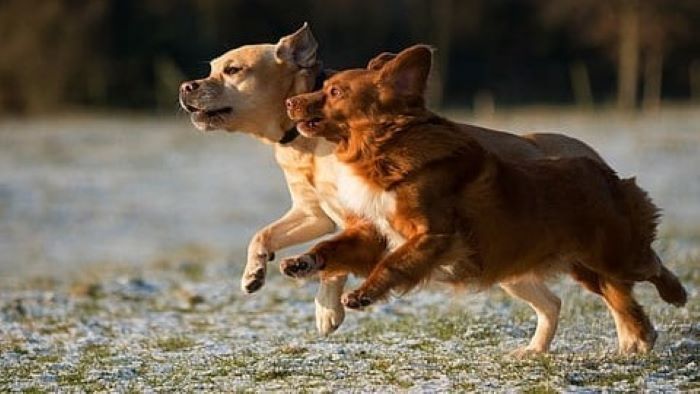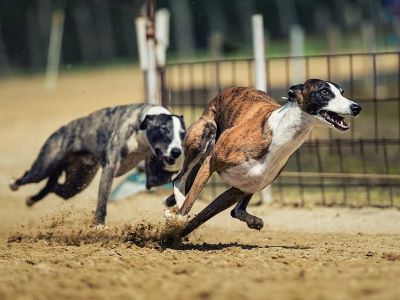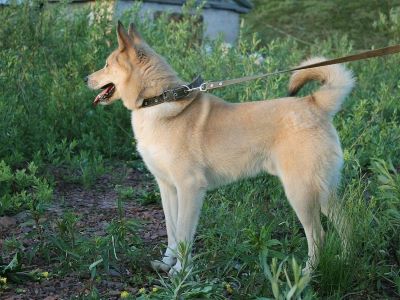Want a furry friend to run with you? A dog that loves to exercise can be an excellent running companion. Running with your dog is a great way to bond while getting fresh air and exercise. Wondering: “How Fast Can A Dog Run?”
It also begs the question of how dogs can run that fast. We aim to cure your curiosity. Keep reading!

How Fast Can A Dog Run?
A dog’s speed depends on many factors like body structure, age, size, and breed. A puppy will not run as fast as an adult dog can. It is common for athletic canines to have larger bodies, which also means that they have larger lung capacities. Some dog breeds, like Greyhounds, have an advantage over other breeds because their hearts are larger than other breeds.
Canines are remarkable creatures with varying physical abilities. Across all dog breeds, we have an average pace of 15-20 miles per hour. However, some breeds are slower than average while some breeds are faster than average.
The fastest dog is the Greyhound, averaging 45 miles per hour. Their inverted S-shaped anatomy gives them a deep chest which offers lung capacity. And a flexible spine that allows them to contract and push their body ahead. For years, Greyhounds were bred for speed, practicing selective breeding. The aim of selective breeding to create a lineage of greyhounds that are consistent with their trait of speed and agility.

While the slowest dog is the Shih Tzu, averaging 6 miles per hour. This is due to their small body and short legs. In brachycephalic breeds (Pugs, Bulldog, French Bulldog, even Shih Tzu) because of their flat nose, they cannot breath as efficiently as other breeds and thus are among the slowest.

“Any of these upper airway abnormalities can cause increased airway resistance, increasing the effort required to inhale,” says Malcolm Weir from VCA Animal Hospitals.“Most dogs with this syndrome breathe more easily through their mouths than their noses. The more abnormalities present, the more severe the signs.”
Why Can Dogs Run Fast?
Dogs’ speed and agility depend on paw design, which can be compared to a pair of shoes. Their nails, for example, offer traction on various surfaces, making it easier for them to move quickly. Their paws’ size and form also have a significant impact on how quickly they can move.
“Composed of keratin, collagen, and adipose, paw pads serve a number of useful functions,” says Melvin Peña from Dogster.“The digital, metacarpal, and metatarsal paw pads act as shock absorbers for the bones and joints that make up the dog’s feet and legs, while the cone-shaped carpal pad aids a dog with balance, slowing down, and stopping.“
Similar to horses, dogs can gallop. The dog flexes their tummy and spine while using all four of its legs. Certain breeds can run like cheetahs—they have a double-suspension gait[1]. The front legs can take the longest stride by going directly beneath the shoulders, with the back feet taking off.
Dogs have an advantage physiologically. They do not have collarbones, so their shoulders are very flexible. This makes them enjoy greater stride and movement. The tail[2] of a dog plays a crucial role in their balance and gait development. When a dog moves, their tail acts as a counterbalance, helping them to maintain stability and control.

Should You Encourage Running?
Dogs used to hunt for food in the past. Later, aristocrats and nobility would frequently take their trained hunting dogs along on hunting expeditions. Among the trained dogs there were Greyhounds and Dalmations. Thus, it is an evolutionary trait to run.
Today you may notice your dog get the zoomies[3] and run around the house or just run in the backyard. Now, as long as your pup isn’t scaring away birds and cats from running, there is no reason to discourage this behavior. In fact, running makes for a great exercise, it’ll keep your pet healthy. You as a pet parent could accompany them. Going on runs together is a fun activity and can help form a better bond.

FAQs
How fast can a dog run?
A dog’s speed is determined by several factors, including size, breed, and age. The average recorded speed is 15-20 miles per hour. Some breeds are slower than the average speed and some dogs are faster than the average speed. The fastest dog is Greyhound while the slowest is Shih Tzu.
Why do dogs run so fast?
Dogs can run fast because of their physiological design. They have no collar bones, their spine is flexible and their paws are like shoes. It is their predatory instinct to run fast. They can be trained to run at your own pace.
Are cats faster than dogs?
It is difficult to compare the speeds of dogs and cats because of differences in breed, age, degree of fitness, and health. Cats and dogs both descend from predators or hunters. While some canines might move more slowly than cats, some might be the contrary.
How long can dogs run without stopping?
In general, most dogs run in short bursts of energy. Dogs like Border Collies and Siberian Huskies were trained during the war and other severe conditions to run for long to deliver messages. Long-distance running is not suitable for dogs.
What is the fastest dog breed?
Greyhounds are the fastest dog breed. They can average up to 45 miles per hour. Greyhounds have been blessed and are naturally athletic. Their body is shaped like an inverted S with a deep chest. They have a bigger heart than other dogs and can pump blood much faster.
Conclusion
You can train your pup to run at your pace and go on runs together. We hope you have a great fitness journey with your pooch. They will begin to trust you more and follow you more. You will develop a deeper bond with your pet.
Hopefully, we could cure your curiosity about: “How Fast Can A Dog Run?” Feel free to browse other topics that are on this page and learn something new about your furry friend.
References:
- Canine Gait analysis. Today’s Veterinary Practice.
- Why do dogs have tails? American Kennel Club.
- What are zoomies? Cornell University College of Veterinary Medicine.



